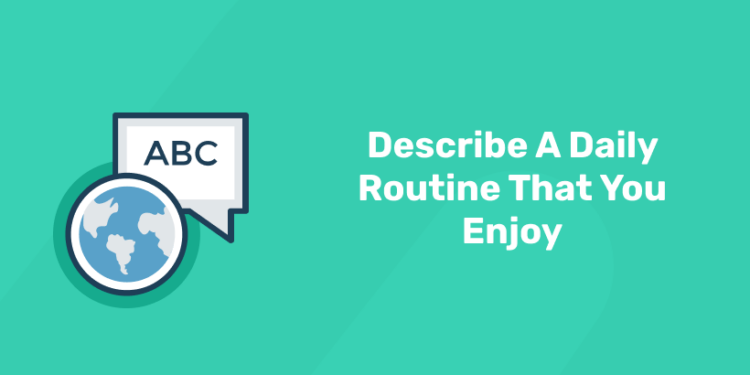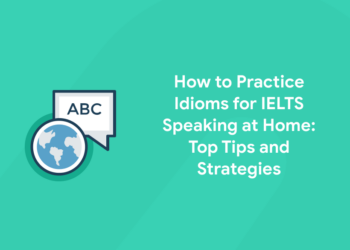When it comes to English language proficiency tests like IELTS or other spoken English assessments, candidates often encounter cue card questions. These questions are designed to test fluency, vocabulary, coherence, and the ability to think on the spot. One common category of cue card questions involves describing an experience or an event from daily life. A popular example is:“Describe a daily routine that you enjoy.”
For many learners, such questions can seem straightforward, but they are a crucial part of the speaking exam where organization, vocabulary, and clarity matter. Answering such questions effectively requires a blend of clear thinking, structured delivery, and relevant content.
In this blog, we will explore how to approach this particular cue card topic, provide a structured answer, and offer tips for improving your preparation. Let’s break down the question, organize a response, and practice together.
Master the IELTS Exam with Online Coaching – Enroll Today!
Describe A Daily Routine That You Enjoy
How to Approach ‘Describe a Daily Routine That You Enjoy’
Let’s now dive deeper into how to approach this type of question. You’ll often find variations of these questions in your speaking tests, and understanding how to tackle them effectively will give you an edge. The cue card may look something like this:
- Describe a daily routine that you enjoy.
- You should say:
- What the routine is.
- When you do it.
- What it involves.
- And explain why you enjoy it.
This type of question encourages you to talk about a specific activity or routine in your life. The key to a good answer is ensuring that your response is detailed, structured, and personal. Here are the steps you can follow:
Step 1: Understand the Question Deeply
It is crucial to fully understand the question before beginning your response. Often, test-takers rush into an answer without breaking the question down, which can result in an answer that lacks depth or structure. Here’s how you can analyze the key elements of the question:
- “Describe”: This word signals that the examiner wants a comprehensive answer. This is not a question you can answer with just a sentence or two. You need to describe the routine in detail. This includes talking about the different aspects of the routine (what you do, how long it takes, when you do it, etc.).
- “A daily routine”: The focus is on something you do regularly, something that is part of your daily schedule. You should talk about one specific routine rather than multiple things you do in a day. For example, rather than talking about your whole morning routine, you could focus on something specific like your workout, meditation, or reading time.
- “That you enjoy”: This part of the question is important because it asks you to talk about something you like or find pleasure in. The examiner will be looking for why this routine is enjoyable for you. Does it relax you, energize you, or help you feel accomplished?
Step 2: Reflect on Your Own Daily Routines
To prepare for this type of question, it’s a good idea to think about your daily routines ahead of time. Here are a few examples of daily routines you might enjoy and why they could make a good answer:
- Morning coffee or tea preparation: This could be a simple yet enjoyable routine because it helps you wake up and feel ready for the day. You could talk about the process of making the coffee, the aromas you enjoy, and how it gives you a moment of peace before the day begins.
- Evening walk or jog: Physical activity is a great routine to discuss because it has both physical and mental benefits. You can describe how you feel refreshed after your walk or jog, the places you like to go, and the peaceful time you spend with yourself.
- Reading before bed: This could be a calming and enjoyable routine because it helps you relax and disconnect from the day. You can talk about the types of books you read, why you find this time important, and how it affects your sleep or mood.
Step 3: Organize Your Thoughts
Before speaking, it’s helpful to organize your thoughts. You don’t need to write everything down, but having a mental outline will help you stay focused and ensure that you cover all parts of the question. Here’s a simple outline you can use:
- Introduction: Briefly introduce the routine and explain when it takes place (morning, afternoon, or evening).
- Describe the Routine: Talk about what you do step-by-step. Be as detailed as possible. Mention any specific things you do during the routine that make it enjoyable.
- Why You Enjoy It: This is the most important part of your answer. Explain why you look forward to this routine and how it benefits you. Does it help you relax, stay organized, or maintain your health?
- Impact on Your Day: Wrap up your answer by talking about how this routine influences the rest of your day. Does it set the tone for your mood or productivity?
Step 4: Use Descriptive Language
To make your answer more engaging and vivid, try to use descriptive language. Instead of saying, “I jog every morning,” you could say, “I lace up my running shoes every morning at 6 AM, just as the sun starts to rise, and head to the park for a refreshing 30-minute jog. The crisp morning air fills my lungs, and the sound of birds chirping helps me clear my mind.”
Adding sensory details (sight, sound, smell, touch, and taste) can make your description more compelling.
Structuring Your Answer: The Ideal Format for ‘Describe a Daily Routine That You Enjoy’
A well-structured response is crucial to scoring high marks in a speaking test. It helps you stay focused and ensures that your answer is easy for the examiner to follow. Here’s an expanded version of the structure you can use:
1. Introduction
Start your answer by introducing the routine you want to talk about. Give a brief overview of what the routine is and when you usually do it. You can also mention why you chose to talk about this particular routine.
Example: “One of my favorite daily routines is my morning coffee ritual. Every day, right after I wake up, I spend a few quiet moments preparing and enjoying my cup of coffee. It’s a simple routine, but it has become an essential part of my day.”
In this introduction, you are giving the examiner a clear idea of what you are going to talk about and why it is important to you.
2. Describe the Routine in Detail
After your introduction, describe your routine step by step. Be as specific as possible. Include details about what you do, how long it takes, and any tools or equipment you use. This is where you can really showcase your vocabulary and descriptive skills.
Example: “My coffee routine usually starts around 7 AM. I begin by grinding fresh coffee beans, which I always buy from a local roaster. I love the smell of freshly ground coffee beans—it instantly wakes me up. Then, I boil some water and pour it slowly over the ground coffee in a French press. While I wait for the coffee to brew, I take a moment to stretch and look out the window, appreciating the calm before the day begins.”
This description gives the listener a clear image of what the routine involves and adds sensory details (the smell of coffee, the act of stretching) to make it more engaging.
3. Explain Why You Enjoy It
The most important part of this question is explaining why you enjoy the routine. This is where you can personalize your answer and show how this routine positively impacts your life. Think about the emotional, physical, or psychological benefits that this routine brings you.
Example: “I really enjoy this routine because it gives me a few peaceful minutes to myself before the chaos of the day starts. It helps me wake up slowly and set a positive tone for the day. The aroma and taste of the coffee are comforting, and I find the process of making it relaxing. It’s also a small accomplishment first thing in the morning—it makes me feel productive even before I start working.”
In this part of your answer, you’re focusing on why the routine is enjoyable, and how it makes you feel. This helps the examiner understand your personal connection to the routine.
4. Impact on Your Day
To finish your answer, talk about how this routine influences the rest of your day. Does it help you stay productive? Does it put you in a good mood? Does it improve your health or well-being? This adds depth to your answer and helps you conclude on a positive note.
Example: “This routine sets the tone for my entire day. After I finish my coffee, I feel more focused and ready to tackle my tasks. I’ve noticed that on days when I skip this routine, I feel a bit more rushed and less centered. It’s a small habit, but it makes a big difference in how I approach the rest of the day.”
By linking the routine to your overall well-being, you’re showing the examiner that this is more than just a simple activity—it’s something that has a meaningful impact on your life.
Example Answer: A Model Response for ‘Describe a Daily Routine That You Enjoy’
Now, let’s look at an expanded model response. This will give you a clear idea of how to structure your answer and what kind of details to include.
Introduction
“One of my favorite daily routines is my morning workout session. I usually work out in the mornings before I start my day, and it has become something I really look forward to. It helps me wake up, feel energized, and stay healthy.”
This introduction gives a brief overview of the routine and sets the stage for the more detailed description that follows.
Description of the Routine
“My workout routine starts at around 6:30 AM. I begin with a 5-minute warm-up, which usually consists of light stretches and a few jumping jacks to get my blood flowing. After that, I do a combination of cardio exercises and strength training. I typically spend about 20 minutes on cardio, either running on the treadmill or doing high-intensity interval training (HIIT) exercises like burpees, mountain climbers, and squat jumps. After cardio, I switch to strength training, focusing on different muscle groups each day. Some days, I work on my upper body with push-ups and dumbbell exercises, while other days, I focus on my legs with squats and lunges.”
Here, the routine is described in detail, covering what activities are involved and how long each part of the routine lasts. This kind of detailed explanation shows the examiner that you are able to clearly describe an activity.
Why I Enjoy It
“I enjoy this routine for several reasons. First, it helps me stay fit and healthy, which is really important to me. I’ve noticed that when I work out in the mornings, I feel more energetic throughout the day, and I’m in a much better mood. It also gives me a sense of accomplishment right at the start of the day. Even if the rest of the day doesn’t go as planned, I know I’ve done something good for my body. Plus, working out helps me relieve stress. I find that when I exercise regularly, I’m less anxious and better able to handle whatever challenges come my way.”
This section explains the personal reasons why the routine is enjoyable, focusing on both physical and mental benefits. It makes the answer more personal and relatable.
Impact on My Day
“My morning workout has a huge impact on the rest of my day. It helps me feel more alert and focused, which improves my productivity at work. I also find that I make healthier choices throughout the day when I start with exercise—I’m more likely to eat well and stay active. Overall, this routine keeps me balanced, both physically and mentally.”
By concluding with the impact the routine has on your day, you’re giving the examiner a complete picture of why this activity is meaningful to you.
Master the IELTS Exam with Online Coaching – Enroll Today!
Additional Model Responses for ‘Describe a Daily Routine That You Enjoy’
To give you a better sense of how you can approach this question, here are a few more model answers, each focusing on different routines.
Model Response 1: Evening Reading Routine
Introduction:
“One of the daily routines I really enjoy is reading before bed. Every evening, I spend about 30 minutes reading a book, and it’s something that helps me relax and unwind after a long day.”
Description of the Routine:
“My reading routine starts at around 9:30 PM, just before I go to bed. I like to make a cup of herbal tea and get into bed with a good book. I usually read fiction because it helps me escape from the stresses of the day. I prefer paperback books over e-books because I find the physical act of turning pages more satisfying. I always make sure to read for at least 30 minutes, even if I’m tired, because it helps me transition from the busy day to a more peaceful night.”
Why I Enjoy It:
“I enjoy this routine because it gives me some quiet time to myself. It’s a break from screens and technology, and it helps me clear my mind before sleeping. I also love getting lost in a good story—reading takes me to different worlds and introduces me to new ideas and perspectives. It’s both relaxing and intellectually stimulating.”
Impact on My Day:
“This routine has a positive impact on my sleep quality. I’ve noticed that when I read before bed, I fall asleep more easily and sleep more deeply. It also helps me de-stress, so I wake up feeling more refreshed and ready to face the next day. Overall, it’s a routine that improves both my mental and physical well-being.”
Model Response 2: Morning Meditation Routine
Introduction:
“A daily routine that I really enjoy is my morning meditation. I’ve been meditating for about 10 minutes every morning for the past year, and it’s become an important part of my day.”
Description of the Routine:
“I usually meditate right after I wake up, around 7 AM. I sit on a cushion in a quiet corner of my room, close my eyes, and focus on my breathing. I use a meditation app that guides me through the process, helping me relax and clear my mind. Sometimes, I practice mindfulness meditation, where I simply observe my thoughts and sensations without judgment. Other times, I do a guided visualization, imagining a peaceful place or a positive outcome for the day.”
Why I Enjoy It:
“I enjoy this routine because it helps me start the day with a clear and calm mind. Meditation helps me manage stress and stay focused throughout the day. I find that I’m more present and less reactive when I meditate regularly. It’s also a time for self-reflection—I often come out of my meditation with new insights or ideas.”
Impact on My Day:
“Meditating in the morning has a big impact on how I approach the rest of the day. I feel more grounded and centered, which makes it easier to handle challenges or stressful situations. It also improves my concentration, so I’m more productive at work. Overall, meditation helps me stay balanced and emotionally resilient.”
Tips for Practicing and Preparing for the ‘Describe’ Cue Cards
To excel at answering “Describe” cue card questions, preparation is key. The more you practice, the more comfortable and confident you will feel during the test. Here are some practical tips for preparing and practicing your responses.
1. Practice with a Variety of Topics
The best way to prepare for cue card questions is to practice answering a variety of topics. While today’s topic is “Describe a daily routine that you enjoy,” there are many other common themes that may come up, such as:
- Describe a memorable vacation you took.
- Describe a hobby you enjoy.
- Describe a person who inspires you.
By practicing different topics, you’ll become more comfortable thinking on your feet and expressing your ideas clearly.
2. Time Yourself
In most speaking tests, you will have a limited amount of time to answer each cue card question. For example, in the IELTS exam, you are usually given 1-2 minutes to speak. Practicing with a timer will help you get used to organizing your thoughts quickly and speaking within the time limit.
Here’s how you can practice:
- Set a timer for 1 minute and give yourself a moment to think about the question.
- Then, set another timer for 2 minutes and try to speak for the entire time without pausing too much.
This will help you build fluency and ensure that you don’t run out of things to say during the test.
3. Record and Listen to Your Responses
Recording yourself while practicing is a great way to identify areas for improvement. When you listen back to your recording, pay attention to the following:
- Are you speaking fluently, or are there too many pauses?
- Are your ideas organized and easy to follow?
- Are you using a range of vocabulary and sentence structures?
By analyzing your performance, you can work on specific areas, such as improving your fluency, expanding your vocabulary, or using more complex grammar structures.
4. Expand Your Vocabulary
While it’s important to keep your language simple and clear, having a good range of vocabulary will help you describe your ideas more effectively. For example, instead of saying “I like my morning coffee,” you could say “I relish the quiet moments spent sipping my morning coffee.” Expanding your vocabulary will allow you to express your ideas in more detail and add variety to your speech.
You can build your vocabulary by reading English books, watching English-language movies or shows, and practicing speaking with native speakers. Make a habit of learning new words and phrases, and try to use them in your practice answers.
5. Focus on Pronunciation and Intonation
Clear pronunciation and natural intonation are key components of good spoken English. When practicing your cue card responses, focus on pronouncing words correctly and using natural intonation patterns. This will make your speech more engaging and easier to understand.
Here are a few tips for improving your pronunciation and intonation:
- Practice difficult words by breaking them down into syllables and saying them slowly.
- Listen to native speakers and pay attention to how they stress certain words and phrases.
- Use rising intonation at the end of questions and falling intonation at the end of statements.
If you struggle with pronunciation, consider working with a language tutor or using language apps that provide feedback on your pronunciation.
6. Stay Calm and Confident
Finally, it’s important to stay calm and confident during your speaking test. Nervousness can lead to hesitation, which can affect your fluency and coherence. Here are a few strategies to help you stay calm:
- Take a deep breath before you start speaking.
- Focus on speaking clearly and at a steady pace—there’s no need to rush.
- If you make a mistake, don’t panic. Correct yourself if necessary, but keep going.
Confidence comes with practice, so the more you prepare, the more comfortable you will feel on test day.
Master the IELTS Exam with Online Coaching – Enroll Today!
Conclusion: Mastering the ‘Describe’ Cue Card Questions
In conclusion, mastering the “Describe” cue card questions requires a combination of preparation, practice, and a structured approach. Whether it’s describing a daily routine, a favorite hobby, or a memorable experience, the key to success lies in organizing your thoughts, using descriptive language, and expressing your ideas clearly.
By following the tips outlined in this blog, you’ll be able to approach cue card questions with confidence. Remember to practice regularly, expand your vocabulary, and focus on delivering well-structured and engaging responses. With time and effort, you’ll improve your fluency, coherence, and overall performance in speaking tests.
Good luck with your practice, and remember: every routine, no matter how simple, can be turned into an interesting story if you approach it with the right mindset!
Ace Your IELTS Exam with Confidence!
Unlock your potential with our expert-led IELTS preparation course. Achieve your dream score and open doors to global opportunities!
Start Your IELTS Journey Today!Frequently Asked Questions
What is a cue card in speaking tests?
A cue card is a prompt or topic provided during speaking tests (like IELTS, TOEFL, etc.) that asks you to speak for 1-2 minutes about a specific subject. It includes a main question and some bullet points to help guide your answer. You are given a minute to prepare before you start speaking.
How can I effectively answer a cue card question like "Describe a daily routine that you enjoy"?
The key to effectively answering a cue card question is to structure your response. Start by introducing the routine, describing it in detail, explaining why you enjoy it, and finally, discussing how it affects your day. Focus on being clear, detailed, and personal in your answer.
What should I include in the "Describe a daily routine that you enjoy" answer?
You should include:
- A clear description of the routine (what you do, when you do it, and how long it takes).
- Specific activities involved in the routine.
- Why you enjoy this routine (emotional, mental, or physical benefits).
- How this routine impacts your mood, productivity, or overall well-being.
How can I expand my answer if I run out of things to say?
If you feel like your answer is too short, try expanding it by:
- Adding sensory details (e.g., sounds, smells, sights).
- Discussing how the routine has evolved over time.
- Including any challenges or difficulties you’ve faced with the routine and how you’ve overcome them.
- Explaining how this routine compares to other daily activities you do.
What are some examples of enjoyable daily routines that can be described?
Some examples include:
- Preparing and enjoying a cup of coffee or tea in the morning.
- A morning or evening jog.
- Reading before bed.
- Doing yoga or meditation.
- Taking a relaxing walk after work.
- Preparing meals or cooking. Each of these routines can be described in detail with reasons why they are enjoyable.
What are some common mistakes to avoid when answering cue card questions?
Common mistakes include:
- Speaking too briefly and not providing enough detail.
- Going off-topic and not addressing the specific question.
- Using overly complicated or unnatural vocabulary.
- Speaking too fast due to nerves, which can make your answer harder to follow.
- Forgetting to explain why you enjoy the routine or how it affects your day.











